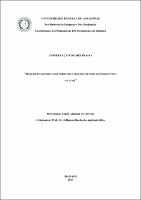| ???jsp.display-item.social.title??? |


|
Please use this identifier to cite or link to this item:
https://tede.ufam.edu.br/handle/tede/4498| ???metadata.dc.type???: | Dissertação |
| Title: | Análise fitoquímica dos extratos e frações obtidos de Himatanthus sucuuba |
| ???metadata.dc.creator???: | Oliveira, Aimêe Almeida de  |
| ???metadata.dc.contributor.advisor1???: | Silva, Jefferson Rocha de Andrade |
| ???metadata.dc.contributor.referee1???: | Pinheiro, Maria Lúcia Belém |
| ???metadata.dc.description.resumo???: | A família Apocynaceae apresenta uma grande diversidade de metabólitos secundários, com potencial biológico e farmacêutico, o que tem despertado grande interesse nos estudos de seus gêneros. O gênero Himatanthus possui treze espécies que estão amplamente distribuídas na região norte do Brasil. A espécie da região amazônica, Himatanthus sucuuba, é latescente, arbórea, cujo tronco é ereto e a casca rugosa, popularmente conhecida como sucuba, sucuuba ou janaguba. O látex, cascas e folhas são utilizados na medicina popular como antitumoral, antifúngico, antianêmico, vermífugo e no tratamento de gastrites e artrites. No presente estudo as raízes de H. sucuuba foram utilizadas para a obtenção dos extratos hexano, diclorometano e metanol. Do extrato hexano foi isolada a mistura dos cinamatos de lupeol, α e β-amirina. O extrato diclorometano foi submetido a fracionamento cromatográfico fornecendo os iridóides plumericina, isoplumericina, plumieridina e o esteróide sitosterol. Do extrato metanol foram isoladas, após sucessivos fracionamentos, o iridóide plumierídeo, e os terpenos acetato de lupeol e a mistura dos ácidos ursólico e oleanólico. A atividade antioxidante foi avaliada por meio da capacidade de sequestro do radical estável 2,2- difenil-1-picrilhidrazila (DPPH), utilizando quercetina como padrão. O extrato metanol das raízes secas/parte diclorometano foi o extrato com melhor atividade antioxidante com a concentração de CS50 em 244, 56 μg/mL. No teste de toxicidade frente à Artemia salina o extrato hexano obtido da raiz fresca, apresentou a atividade mais pronunciada 111,06 μg/mL. A quantificação de iridóides em diferentes espécies do gênero Himatanthus comprovou a presença do plumierídeo constituinte majoritário em todas as espécies analisadas. As análises de diferentes amostras realizadas pela cromatografia líquida de ultra eficiência acoplada ao espectrômetro de massas (CLUE-EM) conduziu à identificação dos iridóides 15-desmetilplumierideo e plumierídeo, presentes apenas nos frutos verdes da espécie H. sucuuba. |
| Abstract: | The family Apocynaceae presents a wide variety of secondary metabolites with potential biological and pharmaceutical activities, which has attracted great interest in studies of their genres. The genus Himatanthus has thirteen species that are widely distributed in northern Brazil. The species of the Amazon region, Himatanthus sucuuba is a latex containing tree, whose trunk is erect and rough skin, popularly known as sucuba, sucuuba or janaguba. The latex, barks and leaves are used in folk medicine as antitumor, antifungal, anti-anemic, anthelmintic and for treatment of gastritis and arthritis. In the present study the roots of H. sucuuba were used to obtain hexane, dichloromethane and methanol extracts. From the hexane extract was isolated the mixture of lupeol cinnamates, α and β-amyrin. The dichloromethane extract was subjected to fractionation providing the iridoids plumericine, isoplumericine, plumieridine and the steroid sitosterol. From the methanol extract were isolated after successive fractionations, the iridoid plumieride and the terpenes lupeol acetate and the mixture of ursolic and oleanolic acids. The antioxidant activity was evaluated by sequestration capacity of the stable radical 2,2 - diphenyl-1-picrylhydrazyl (DPPH) using quercetin as standard. The methanol extract of the dried roots / the dichloromethane extract was better with antioxidant activity with the concentration of CS50 in 244.56 mg/mL. The toxicity test on Artemia salina hexane extract obtained from the fresh root, showed activity more pronounced at 111.06 mg/mL. Quantification of iridoids in different species of the genus Himatanthus proved the presence of plumieride as the major constituent in all analyzed species. The analysis of different samples analyzed by ultra efficient liquid chromatography coupled with mass spectrometry (UPLC-MS) led to the identification of iridoid 15-desmethylplumieride and plumieride, present only in the green fruits of the species H. sucuuba. |
| Keywords: | Apocynaceae Himatanthus sucuuba Iridóides Apocynaceae Himatanthus sucuuba Iridoids |
| ???metadata.dc.subject.cnpq???: | CIÊNCIAS EXATAS E DA TERRA: QUÍMICA |
| Language: | por |
| ???metadata.dc.publisher.country???: | Brasil |
| Publisher: | Universidade Federal do Amazonas |
| ???metadata.dc.publisher.initials???: | UFAM |
| ???metadata.dc.publisher.department???: | Instituto de Ciências Exatas |
| ???metadata.dc.publisher.program???: | Programa de Pós-graduação em Química |
| Citation: | OLIVEIRA, Aimeê Almeida de. Análise fitoquímica dos extratos e frações obtidos de Himatanthus sucuuba. 2013. 91f. Dissertação (Mestrado em Química) - Universidade Federal do Amazonas, Manaus, 2013. |
| ???metadata.dc.rights???: | Acesso Aberto |
| URI: | http://tede.ufam.edu.br/handle/tede/4498 |
| Issue Date: | 19-Jul-2013 |
| Appears in Collections: | Mestrado em Química |
Files in This Item:
| File | Description | Size | Format | |
|---|---|---|---|---|
| Dissertação - Aimêe Almeida de Oliveira.pdf | Dissertação - Aimêe Almeida de Oliveira.pdf | 2.73 MB | Adobe PDF |  Download/Open Preview |
Items in DSpace are protected by copyright, with all rights reserved, unless otherwise indicated.




